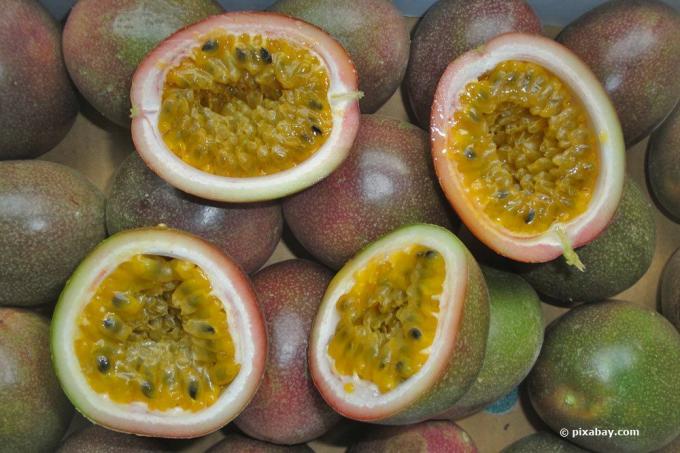
table of contents
- Surname
- differences
- Appearance
- Taste and Ingredients
- Confusion in Commerce
Maracuja or passion fruit? There is a lot of discussion about the correct name for tropical fruits. While some argue that the fruits are the same, others argue that there is a difference between them. However, as almost always, the truth lies in the middle, because in Europe the terms “passion fruit” and “maracuja” are often used synonymously for both fruits.
Surname
The name “Maracuja” is a loan word in Portuguese from the Tupi language, which goes back to the time before the conquest of South America and the Portuguese colonial period. Translated, "Mara" means food and "Cuja" means vessel. The name “passion fruit” goes back to the Christian immigrants from South America. Because they thought in the flowers of Passiflora (Passion flower) to recognize symbolically the passion of Christ. According to the opinion of the time, for example, the ten petals should stand for the apostles (excluding Judas and Peter) and the five stamens symbolize the five wounds of Christ.
differences
Even if the names of the tropical fruits are used synonymously, differences can be determined, because in Germany there is a difference between passion fruit and maracuja. This can be determined at the following points:
- botanical name
- Appearance
- taste
- Botanical name
Both fruits resp. both plants belong to the genus of passion flowers (Passiflora). The “Passiflora edulis” species includes various varieties and forms. The fruits of the forms purple granadilla (Passiflora edulis forma edulis) and yellow granadilla (Passiflora edulis forma flavicarpa) are commercially available. The term “form”, abbreviated to f., Represents a rank below the species in the botanical systematics. It is usually used for visual deviations.
Appearance
The most important difference between the two fruits is their appearance, on which the names purple and Point out yellow granadilla. F. flavicarpa has a brown-purple skin that becomes wrinkled as it ripens. The smooth shell of f. edulis is yellow. Other distinguishing features are the size and shape of the fruits.
Purple granadillas reach a maximum size of a chicken egg and have a spherical to oval shape. The yellow fruits, on the other hand, are significantly larger. They are between eight and twelve centimeters long and have an oval to egg-shaped shape.
There are many seeds inside the fruits, because botanically speaking, the fruits are berries. They are surrounded by a juicy jelly of yellow-orange color. The color of the seeds is different for the two fruits. F. edulis has black seeds, f. flavicarpa brown seeds.
Taste and Ingredients
Taste is discussable. It also depends on the degree of maturity and growth conditions of the plants. Therefore only general statements can be made here. The fruits of the yellow granadilla, the passion fruit, whose acidity is higher, are considered to be somewhat less aromatic than those of the purple granadilla, the passion fruit. This may be one reason why many German supermarkets tend to offer the small, wrinkled fruits, although the yellow fruits are said to be sweeter.
There is no significant difference in the ingredients. The juice or In addition to sugar, the fruit jelly contains plenty of vitamin C as well as niacin (formerly vitamin B3) and riboflavin (formerly vitamin B2).
tip: To taste the real difference, try both fruits once.
Confusion in Commerce
Whether you buy maracujas or passion fruits in stores often depends on the supplier. In German supermarkets, however, the following terminology has been used for tropical fruits:
- yellow fruit = passion fruit
- violet-brown fruit = passion fruit
The purple-brown passion fruit can usually be seen on finished products that are offered in stores, as they look better than the yellow tropical fruit. So it is quite possible that the small passion fruit can be seen on the packaging, even though the product contains passion fruits. This fact may not be so clearly noticeable in the taste, but it often causes confusion. It is also believed that this advertising ploy led to the name “passion fruit” being more common than “passion fruit”.





